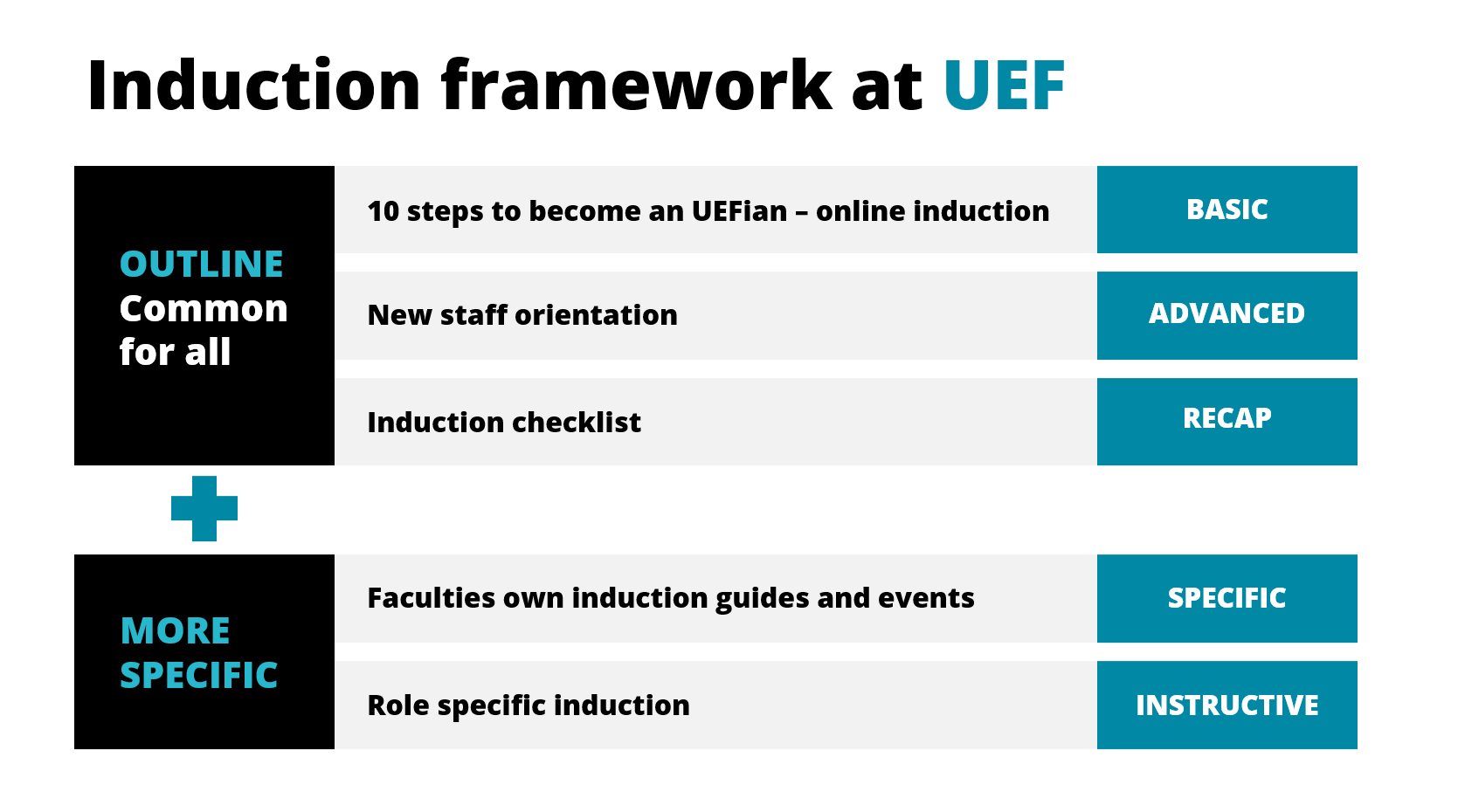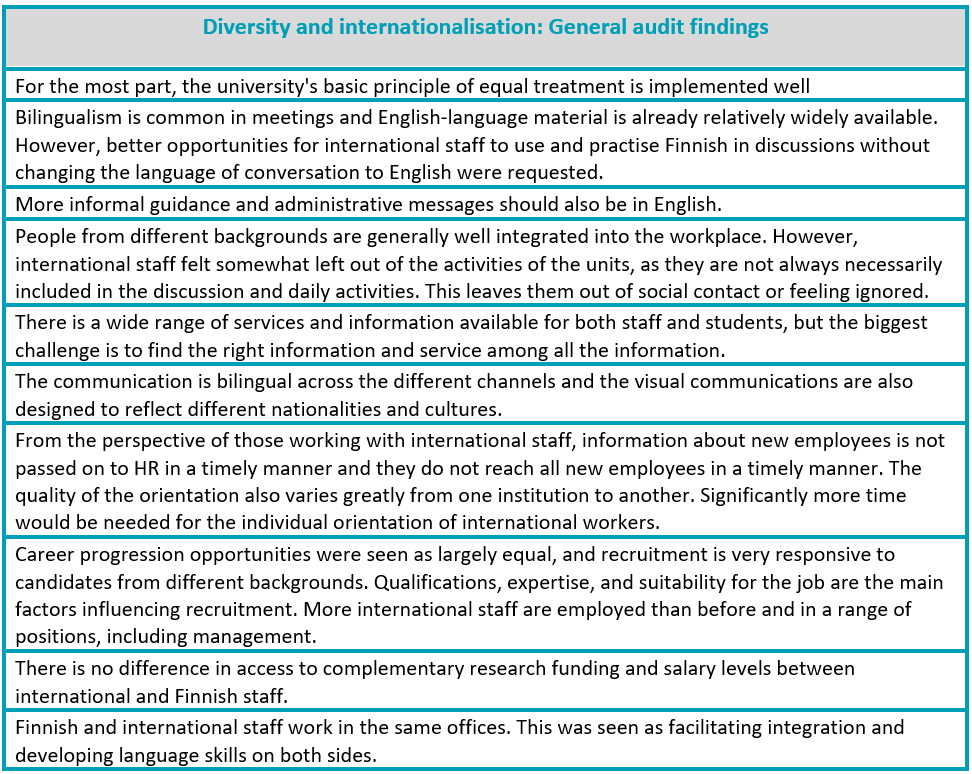University of Eastern Finland as a study and work environment for international students and employees
One of the key priorities of the University of Eastern Finland’s strategy is internationalisation. The key to internationalisation is not only to recruit international staff and students successfully, but also to engage them in the university community. In order to achieve this, the university has chosen as its optional assessment topic The University of Eastern Finland as a study and working environment/community for international students and employees
Orientation and integration of staff in the workplace community
At the university, the staff orientation model is the same for both Finnish and international staff. Although the process itself is similar, more in-depth orientation training is provided for international staff, both at the university level and in faculties, and content is tailored as needed.

Figure 10 Induction framework at UEF
The university has piloted the ’Working in Finnish Universities’ online orientation package. UEF has a 10-step orientation package (online), which sets out the key issues for each new employee.
Welcome to the Team events are held twice a year, in the autumn and spring semesters. Orientation topics include: ‘Working at the UEF – employment relationship’ and ‘Living and working in Finland – essentials of Finnish social security, taxation and health care’.
In accordance with Section 35(2) of the Universities Act (558/2009), the administrative language of the University of Eastern Finland is Finnish. Bilingualism is consolidated in the official policies and institutions of the University. In accordance with the language guidelines of the university, the languages of the university’s meetings are Finnish or English, which can also be used in parallel to ensure everyone’s participation. The languages of the meetings should be chosen so that everyone can participate. Language choices are announced in advance, for example in the invitation to the meeting.
The coexistence of Finnish and English in the university’s functions (the UEF Board, University Collegiate Body, and the Faculty Councils) is made possible by the translation of agendas and minutes in cases in which the function includes non-Finnish speakers. In addition, it has been agreed that the meetings of the steering groups and faculty councils are to be announced in both Finnish and English in order to promote participation.
The university encourages its international staff to learn Finnish and has made Finnish language courses available. Diversity and cultural awareness training is provided for all staff. The goal is increasing the bilingual culture of dialogue at different levels.
The university’s Human Resources Services help faculties and units with the orientation of incoming international staff, whether in relation to the workplace community or the practicalities of living in Finland. For international people coming to work at the university, information is available on a public website. Further guidance for staff hosting international staff is available on the Heimo website. The actual orientation and integration into the workplace community takes place at the unit/department level. In services with a high number of international staff, the picture is different from that of services with a low number of international staff. As a result, the need for support also varies from unit to unit.
The Faculty of Science and Forestry has the highest proportion of international staff among the university’s faculties. The faculty has invested in the orientation process and refined the general orientation guidelines with a faculty-level induction. The A.I Virtanen Institute for Molecular Science has a particularly long history of working to integrate international staff into the workplace community. The NeuroInnovation doctoral programme has done an excellent job of prepping new recruits through virtual meetings even before they arrive in Finland.
There were no significant differences between the responses of international staff and Finnish staff in the University Services Service Survey. Only in terms of access to staff training did international staff perceive the situation to be worse than that of Finnish staff.
Integrating international students into the university community
International students have access to the same study opportunities and learning environments, as well as accommodation in campus towns and cities as Finnish students. Students have been shown to generally group up within their own reference group. However, according to the surveys and questionnaires carried out, international students would like to be more integrated into the wider student community. In addition, employment in the region requires integration into Finnish life.
International students have access to international career services, which should be strengthened. While students see career guidance as important, both the university’s and campus cities’ (incl. Employment Offices) career guidance and integration services are poorly known. International students have their own tutoring, and in the future the intention is to combine both domestic and international tutoring. Weekly meetings of the network of coordinators of international master’s programmes and international student services promote collaboration and the development of common operational model.
International students would like more information and support on issues such as:
- Finnish language and workplace culture, e.g., a FAQ page or Q&A questionnaire
- Employment-related administrative activities, such as residence permits
- Events where businesses and students meet and network
- Career stories of international students who have found employment
- Personalised career guidance at different stages of their studies
In addition to the services provided to international staff and students, the broad promotion of internationalisation also requires measures for the university community as a whole. The key is to make the identified development needs visible. The university’s diversity work outlines measures to promote this objective.
Internationalisation and diversity have been a university-wide theme in the university level.
Internal audits between 2020 and 2022. In the faculties’ and units’ own internal audits, the following findings emerged from interviews with management, staff, and students. International staff were also interviewed.

Figure 11 Findings from internal audits
| Strengths | Enhancement areas |
| Services for international staff and students have been strengthened at different levels | Developing skills in workplace services for diversity mainstreaming |
| Informal meetings between management and international staff | Systematic use of feedback from international students and staff |
| Internationalisation and diversity as part of university management training provides approaches and tools for supervision. | Involving international staff and students in decision-making |
| In the recruitment process, materials and guidance are available in Finnish and English and the application process is transparent | Developing a comprehensive orientation for international staff |
| Leadership’s information sessions and other staff events are bilingual and material is available in two languages. | In cooperation with campus cities and authorities, working together to integrate staff and their families |
| The integration of international staff into the workplace community has been identified as a strong area for development | Strengthening career services for international students |
| The UEF trainee programme supports the employment of international students |